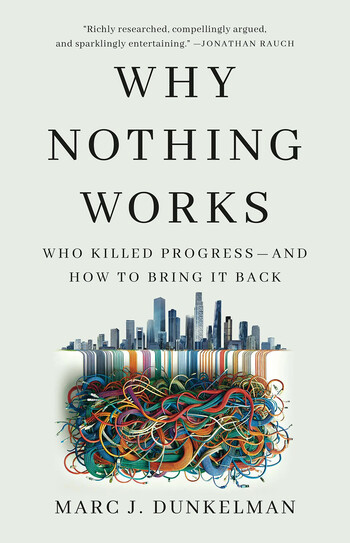The blunt title of Marc J. Dunkelman’s new book, Why Nothing Works, is that political rarity: a statement that finds consensus among all Americans, left, right, and center. Somewhere along the way, we agree, our government became incompetent, unable even to tackle, let alone solve, the nation’s greatest material challenges.
In examining how we got here, Dunkelman ’01CC, a political historian, takes us back to a United States that once moved fast and didn’t break but built things — big things, like public works (dams, reservoirs, and electrification projects that, in the case of the New Deal–era Tennessee Valley Authority, brought electric power to an undeveloped forty-thousand-square-mile swath of the rural South in just over a decade), public spaces (parks, forests, nature trails), and public transportation (tunnels, bridges, railroads, and highways that spanned a continent). How did a public sector capable of such accomplishments devolve into one that, to invoke a widely publicized recent boondoggle, was prepared to spend $1.7 million and ten years to install a single public toilet in San Francisco? Back in the 1930s, ’40s, and ’50s, Robert Moses 1914GSAS, ’52HON, an unelected bureaucrat, all but singlehandedly transformed New York City and its environs, demolishing whole neighborhoods to realize his idiosyncratic vision of modern urbanism. Was everybody suddenly allergic to progress? Where had all the Robert Moseses gone?
Therein lies the rub, because the dilemma raised in Dunkelman’s subtitle (“Who killed progress?”) can in large part be laid at the feet of overreachers and power abusers such as Moses, whose high-handed takeover of New York was charted in the best-selling book The Power Broker, by Robert Caro ’68JRN, released in 1974 as the nation was reeling from the fallout of the Watergate scandal. By then, Americans had already weathered decades of deceit by both government and private industry — about dubious US military interventions, about harmful pesticides and other toxins, about the automobile industry’s disregard for passenger safety. Distrust of powerful institutions, known collectively as “the establishment,” was rampant, and a new generation no longer accepted the truism that, in Dunkelman’s words, “government would fund great endeavors, and those endeavors would be run centrally by great men.”
Enter an era of “guardrails”— important checks on power that were designed to curtail such abuses and restore accountability to the citizens whom government was supposed to serve. The downside? Limitations on power generate so much fine print and so many hoops for planners to jump through that even the worthiest projects often fail to come to fruition.
Dunkelman sets out to untangle this conundrum. He traces modern progressivism, a movement that originated around the turn of the last century, to two distinct strains of American thought — one rooted in the ideas of Alexander Hamilton, who believed that effective governance required power to be consolidated into centralized institutions with strong leaders, and the other in those of Thomas Jefferson, a fervent anti-monarchist who valued the freedom and autonomy of individuals above all. For government to succeed, Dunkelman posits, the two strains must be in balance; when one side veers off-kilter and disturbs the equilibrium, government fails. The two models have moved in and out of dominance, depending on the historical era, and the golden mean Dunkelman envisions has probably never been perfectly struck. In reality, it turns out that breaking things is an inevitable stage in the process of building things. The dams that brought electricity to the impoverished masses of the Tennessee River Valley also flooded thousands of farms and homes, dislocating families who’d lived there for generations. Progress, however defined, always leaves casualties in its wake.
Dunkelman’s tour through this push-pull history is chock-full of revelations and fascinating tidbits. For readers steeped in recency bias, these historical elements provide much-needed perspective. Meanwhile, Dunkelman’s accounts of stymied-at-every-turn present-day projects highlight the headshaking absurdity of a system that he believes has tipped too far in the Jeffersonian direction. Its aversion to power and unwillingness to tolerate any preference for one party’s interests over another’s, Dunkelman argues, have resulted in civic gridlock.
His proposed fix is perhaps the book’s shakiest element. He urges his compatriots to set aside their reluctance to “pull power up” and allow leaders and institutions to exercise more unilateral decision-making power. The fact that this book is dropping at a historical moment when its readers will likely be horrified by the idea of increasing the unilateral power of governmental leaders in no way diminishes Dunkelman’s achievement here. Read the book, ponder its arguments, and let the discussions commence.



